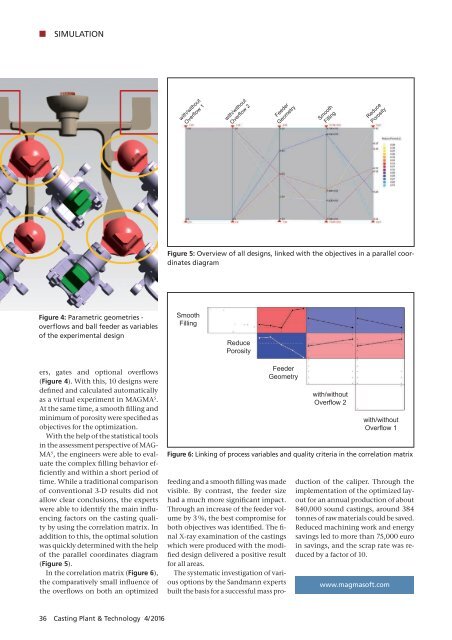CPT International 04/2016
The leading technical journal for the global foundry industry – Das führende Fachmagazin für die weltweite Gießerei-Industrie
The leading technical journal for the
global foundry industry – Das führende Fachmagazin für die
weltweite Gießerei-Industrie
Create successful ePaper yourself
Turn your PDF publications into a flip-book with our unique Google optimized e-Paper software.
K SIMULATION<br />
with/without<br />
Overflow 1<br />
with/without<br />
Overflow 2<br />
Feeder<br />
Geometry<br />
Smooth<br />
Filling<br />
Reduce<br />
Porosity<br />
Figure 5: Overview of all designs, linked with the objectives in a parallel coordinates<br />
diagram<br />
Figure 4: Parametric geometries -<br />
overflows and ball feeder as variables<br />
of the experimental design<br />
Smooth<br />
Filling<br />
Reduce<br />
Porosity<br />
ers, gates and optional overflows<br />
( Figure 4). With this, 10 designs were<br />
defined and calculated automatically<br />
as a virtual experiment in MAGMA 5 .<br />
At the same time, a smooth filling and<br />
minimum of porosity were specified as<br />
objectives for the optimization.<br />
With the help of the statistical tools<br />
in the assessment perspective of MAG-<br />
MA 5 , the engineers were able to evaluate<br />
the complex filling behavior efficiently<br />
and within a short period of<br />
time. While a traditional comparison<br />
of conventional 3-D results did not<br />
allow clear conclusions, the experts<br />
were able to identify the main influencing<br />
factors on the casting quality<br />
by using the correlation matrix. In<br />
addition to this, the optimal solution<br />
was quickly determined with the help<br />
of the parallel coordinates diagram<br />
(Figure 5).<br />
In the correlation matrix (Figure 6),<br />
the comparatively small influence of<br />
the overflows on both an optimized<br />
Feeder<br />
Geometry<br />
Figure 6: Linking of process variables and quality criteria in the correlation matrix<br />
with/without<br />
Overflow 2<br />
with/without<br />
Overflow 1<br />
feeding and a smooth filling was made<br />
visible. By contrast, the feeder size<br />
had a much more significant impact.<br />
Through an increase of the feeder volume<br />
by 3 %, the best compromise for<br />
both objectives was identified. The final<br />
X-ray examination of the castings<br />
which were produced with the modified<br />
design delivered a positive result<br />
for all areas.<br />
The systematic investigation of various<br />
options by the Sandmann experts<br />
built the basis for a successful mass production<br />
of the caliper. Through the<br />
implementation of the optimized layout<br />
for an annual production of about<br />
840,000 sound castings, around 384<br />
tonnes of raw materials could be saved.<br />
Reduced machining work and energy<br />
savings led to more than 75,000 euro<br />
in sa vings, and the scrap rate was reduced<br />
by a factor of 10.<br />
www.magmasoft.com<br />
36 Casting Plant & Technology 4/<strong>2016</strong>


















